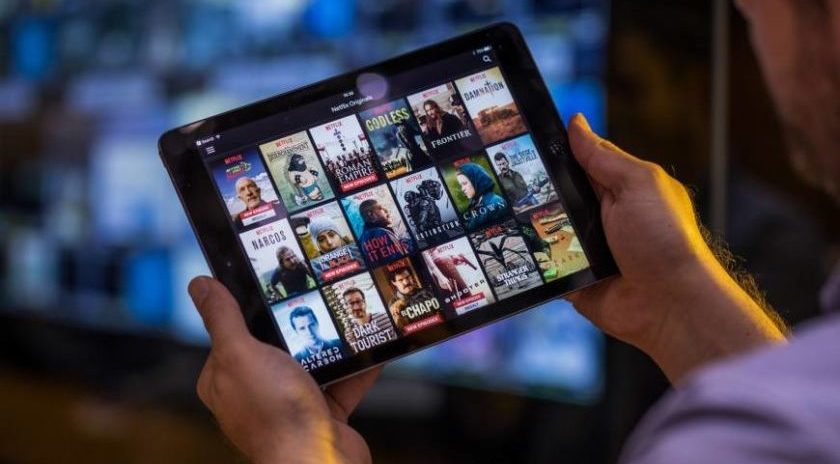M+E Connections

Crossing Borders: Streaming Firms Address Lost Revenue Challenges
Story Highlights
Back in 2017 the company that is synonymous with streaming had this then-odd idea of putting up the full season of shows all at once, allowing people to binge watch it all, instead of waiting for an episode at a time.
It was the ultimate proof of the benefit of VOD entertainment: watch what you want, where you want, when you want, how you want.
Netflix CEO Reed Hastings proudly proclaimed to shareholders — and anyone else who would listen — that their only competition was sleep.
The company’s then 58.4 million subscribers in 190 countries (today 182.8 million subscribers) agreed, giving the company $6.7 billion then ($20 billion-plus in 2019). More importantly so did his shareholders and a growing list of competitors around the globe who could see a big, beautiful market emerging:
• 1.250 billion-plus broadband subscribers globally
• 5 billion-plus mobile subscribers worldwide
• 1 billion-plus pay TV subscribers worldwide
All of them were obviously ready to take advantage of everything Netflix had to offer … all at once.
Many millennials, boomers cited the rising cost of cable as the prime reason they were dropping/shaving their multichannel TV service (pay TV) for OTT viewing. At the same time Gen Z and Alpha folks didn’t have to make this decision because many never had a pay TV service to begin with.
But there was a more important reason. Back when folks were in the office without masks and hollering at each other without social distancing, they talked about the great stuff they watched — depending on their country — on Netflix, Mubi, Acorn.tv, Britbox, Canal+, Hikari, Rakuten, Viu, Baidu, Alibaba, Tencent, Hotstar, Zee 5, Amazon Prime, Salto, MovieStar and the list goes on.
But none of that content was on their cable service … and they wanted it too.
 The second reason was they had kids who really wanted the “new stuff.” The younger group has grown up with a screen in their hands so using their smartphone and/or tablet to stay connected on social media and to their entertainment is … natural.
The second reason was they had kids who really wanted the “new stuff.” The younger group has grown up with a screen in their hands so using their smartphone and/or tablet to stay connected on social media and to their entertainment is … natural.
“The M&E industry has been going through growing pains over the past few years,” Allan McLennan, CEO of PADEM Media Group, said regarding the shift. “Broadband, both fixed and wireless, has become an integral part of our personal and professional connected lives while always on, always available content distribution has been testing the boundaries of local, regional as well as international business models.
“Then the pandemic hit, forcing a hiatus in production of new TV shows and movies around the globe. So, studios/content owners with projects in post couldn’t afford to wait for people to return to the cinema. They began releasing the work to networks, broadcasters or OTT providers to maintain their product exposer and distribution supply chain as well as their cashflow, weighing the pros and cons regarding how future theatrical releases would play out.”
With the uncertainty of a vaccine, production and post are proceeding cautiously and differently from last year to refill the pipeline.
At the same time, the perfect storm — streaming content, people staying at home and acceptable economics — paved the way for a dramatic and what looks like a permanent change of the entire M&E ecosystem.
The industry is gaining a greater understanding — and appreciation — of how the internet can perform when delivering content at scale to an ever-increasing audience.
Akamai and other CDNs have done an excellent job of managing the existing Internet capacity for fast, reliable delivery of games, video on demand and increasingly sports and concert live streams. But the internet capacity and speed are not universal.
As Europeans sheltered in place, the EU asked Netflix, Amazon and YouTube to lower streaming quality (reducing bandwidth requirements) which was done even though Netflix, focused on global growth, had been developing an advanced transmission network for years.
They have deployed more than 4,700 dedicated servers around the globe and especially in areas such as Africa where internet speeds are terribly slow and expensive. These and CDN partner servers help relieve the internet strain.
In addition, they used their own video compression technology to reduce data consumption without diluting the viewing experience.
With their focus on long-term growth they — as well as Amazon and Google — have been intent on removing the economic and content quality barriers in international markets.
That portion is “relatively” easy: all it requires is financial commitment and technology.
 The second issue which neither streamers nor consumers can agree upon is whether to provide binge vs weekly installments. True, TV and movie marathons have been around for decades with VHS, DVD, and holiday, weekend blocks. But Netflix, Hulu, BritBox and others transformed binge-fests into special events to help create viewer growth and loyalty.
The second issue which neither streamers nor consumers can agree upon is whether to provide binge vs weekly installments. True, TV and movie marathons have been around for decades with VHS, DVD, and holiday, weekend blocks. But Netflix, Hulu, BritBox and others transformed binge-fests into special events to help create viewer growth and loyalty.
Hulu, Disney+, Amazon and Apple TV+ have gone the traditional route with weekly episode releases to retain long term interest (and subscriptions). Even Netflix has waffled on what is best having released weekly episodes of “The Great British Baking Show” in the U.S.
Not that they seem to care but we become numb after two hours even when watching the best movie available. The major irritation for most consumers though is that there is global availability and quality of the internet along with spotty availability of services and shows.
In some cases, this is a holdover of governments’ control over what local citizens can read/watch as well as the retention of yesteryear’s time-constrained licensing arrangements. Netflix, Amazon Prime, Apple TV+, Disney +, Hulu and even the ad-supported services develop or license content for worldwide or regional distribution.
A service’s show may be streamed in the U.S. but in England it’s on BBC, in France on Canal, and in Australia on Network10 even when the service is subscribed to by locals. When organisations decide they are going to roll-out their own service (Disney, Warner, etc.) they pull the show so it’s only available on their subscription channel.
If the channel isn’t available in your country? Tough!
Sure folks “hear” about the great new content on the internet … just not where you live.
And if that isn’t bad enough try traveling with your subscription service. When visiting certain countries and crossing their borders, some streaming services don’t have a content passport so it’s unavailable in Mexico, Taiwan or other country (or vice versa) even when your account is current.
Old habits die hard.
One of the key reasons is that the studio/distributor can make money again and again by making the show available on a country-by-country basis.
The solution frequent travellers often use is a virtual private network (VPN) which allows you to connect your system to your home network (and yes, it’s more secure if you also decide to do a little work).
It’s a “good” solution if you’re spending an extended period in the country. And if you do a little planning, you can download your favourites and view those titles wherever you would like.
Okay, it doesn’t work in certain countries such as China but then they have a different description of privacy and security, so tread lightly.
Of course, the jigsaw puzzle of when, where, how the volumes of fantastic IP-based content will be available has also increased piracy, dramatically. Hastings biggest competition wasn’t sleep, it was mooching — loaning, borrowing, using someone’s paid access to watch a show — at the expense of the main subscriber.
McLennan estimated that Netflix loses as much as $192 million every month due to password sharing.
 In addition, the shift to digital and internet production/distribution have negatively impacted the entire M&E ecosystem.
In addition, the shift to digital and internet production/distribution have negatively impacted the entire M&E ecosystem.
While digital rights management (DRM) has proven to be modestly successful it is still ineffective in stopping piracy that is surging everywhere.
“In 2018, 2019 there were signs that piracy was slowing in many parts of EMEA and APAC,” McLennan noted. “But with people confined during the pandemic, piracy surged over 40 percent. That viewing habit shift could become a new behaviour and certainly run the risk of becoming more accepted around the globe.
“The more services overlook password sharing, the more people think it’s ok to download or stream a show now and then, the more it will become an acceptable viewing option. Very few people think of it as actually stealing and the industry has done almost nothing to bring this to their attention through education.”
Obviously streaming services can’t address the issue as the Recording Industry Association of America (RIAA) did years ago, and sue people. We all know how that turned out: the industry got a very black eye.
However, “friendly” reminders or thoughtful discussion will certainly help minimise the problem because it’s not going away.
Being in TorrentFreak’s top ten list doesn’t prove how popular you are but rather how much you lost:
• 130.5 billion viewings worth of U.S-.produced TV episodes were pirated
• TV shows remain the most-popular content among pirates; more than 110 billion visits to pirate sites last year
• Illegal downloading of copyrighted materials consumes 24 percent of global bandwidth
• Annual global movie industry revenue losses are about $97 billion
• The proportion of global internet users who are borrowing account credentials has increased from 8 percent in Q1 2019 to 11 percent in Q1 2020
• Ampere estimates that there are 70 million households borrowing one or more OTT accounts across 22 markets worldwide
• The trend is highest in India, followed by the Netherlands and France, and lowest in Japan
• Account borrowing is growing fastest in the UK, China and Indonesia
“A great proportion of pirating is sports related — soccer, rugby, basketball, baseball, football — because sports are seasonal,” McLennan said. “Since people don’t feel they watch enough to justify a subscription, borrowing credentials and pirating are perceived to be ‘reasonable’ solutions.”
He cited a recent Synamedia report that found loyal stalwarts (26 percent of respondents) live football-focused lives using pay TV. While almost all of the respondents felt it was wrong to watch pirate sports content, more than 35 percent do it at least weekly, more than 50 percent at least once a month.
In addition to “educating” sports fans and general entertainment viewers, better solution to “one price fits all” approaches McLennan suggested for content owners and streaming services would be to offer viewing packages that have varied ranges of sports/entertainment options as well as multiscreen and multi-viewer options.
“People have become accustomed to simply visit websites and stream their entertainment regardless of its origin,” McLennan said. “If they are already paying for three-four established streaming services adding the cost of another service for a few shows would be challenging.
“Especially when a more user-friendly pirate site can meet their occasional needs.”
Producers, actors and the filmmaking crew agree with “Argo’s” Lester Siegel when he said, “If I’m doing a fake movie, it’s gonna be a fake hit.”
However, today’s streaming services have to take the long-term view: what appeals to consumers.
Andy Marken, President, Marken Communications, is an author of more than 700 articles on management, marketing, communications, industry trends in media & entertainment, consumer electronics, software and applications.









